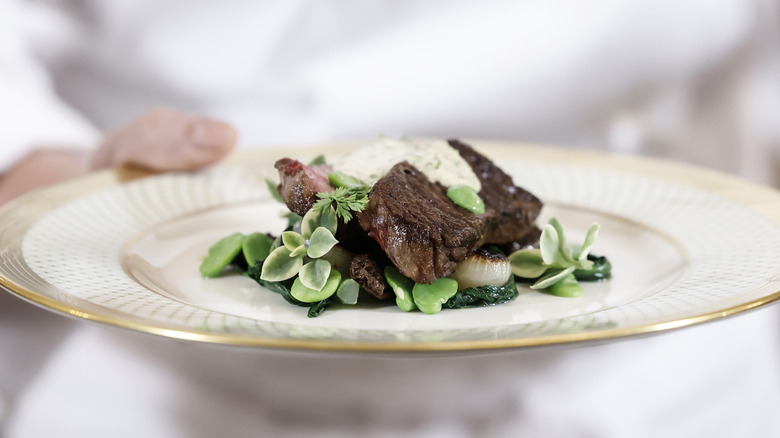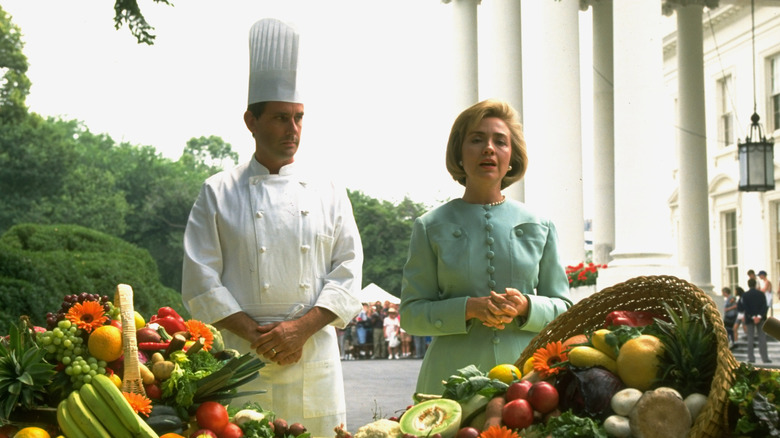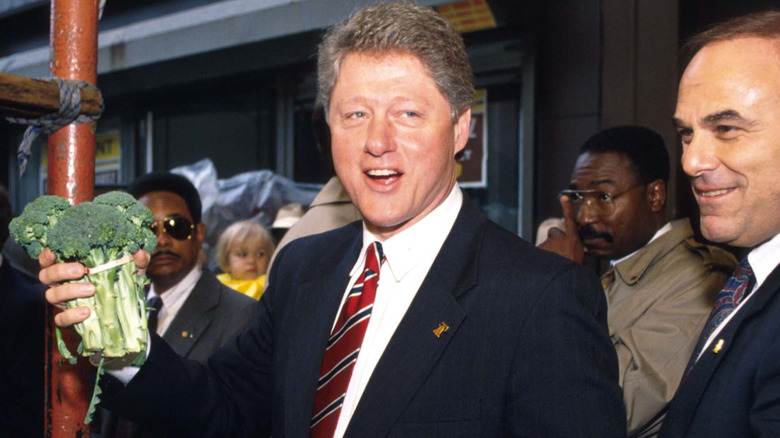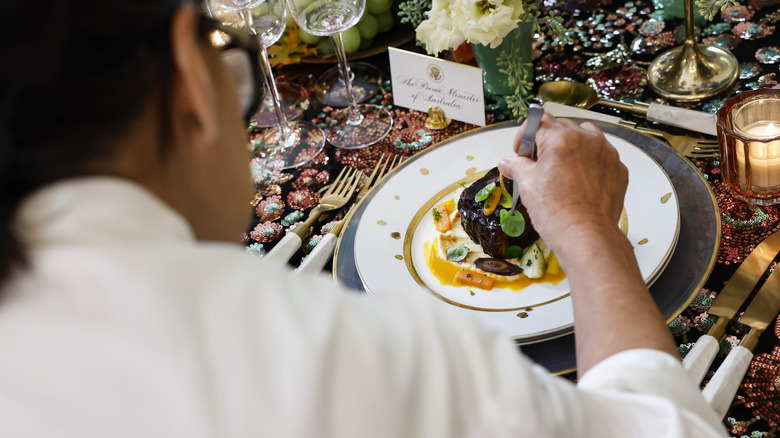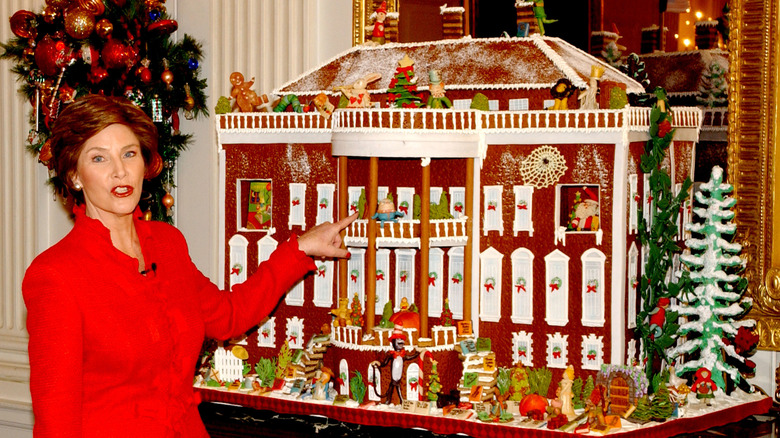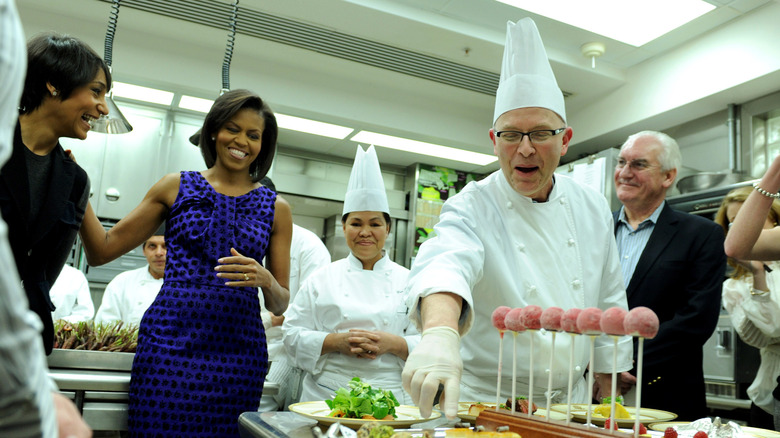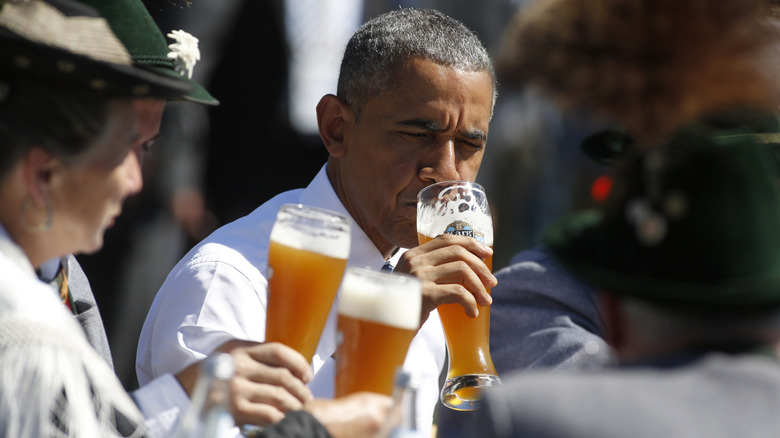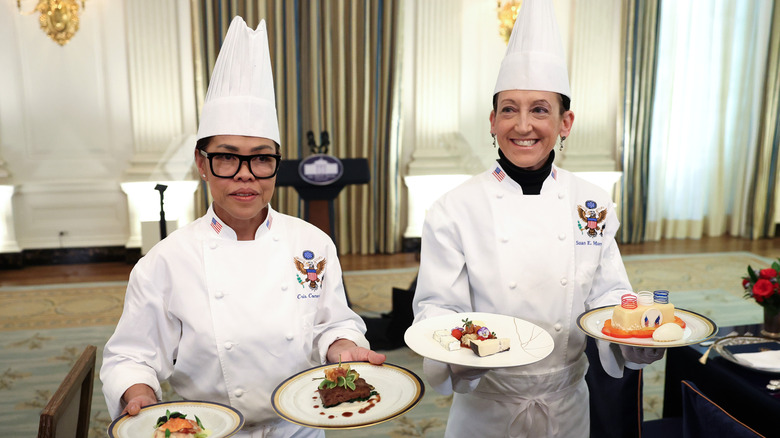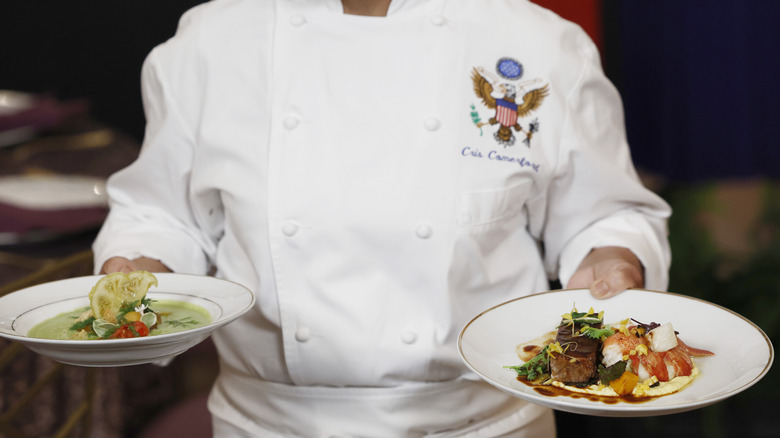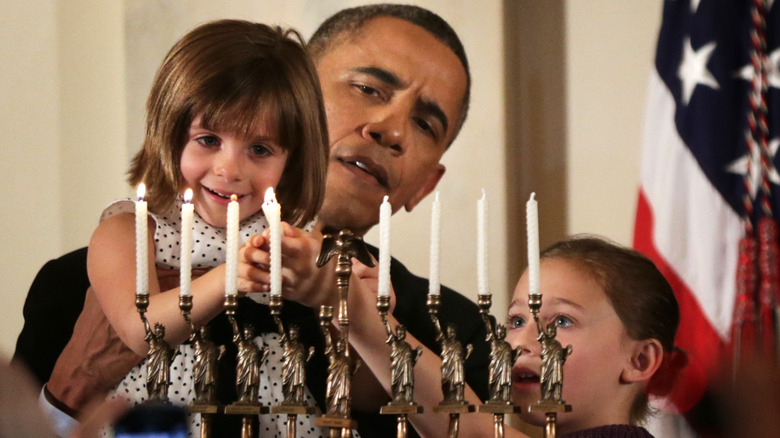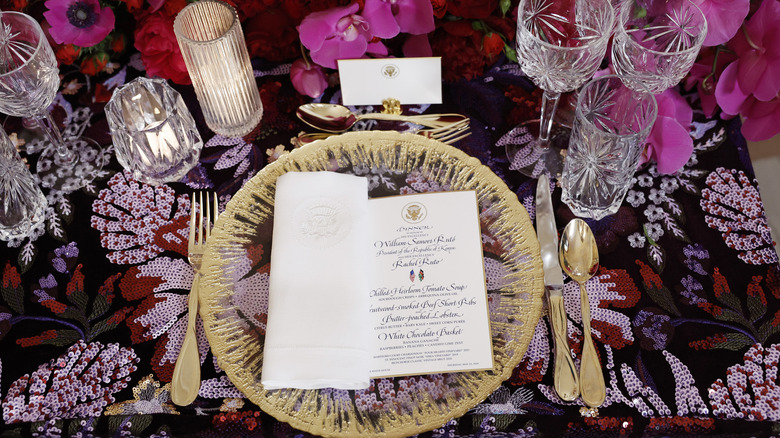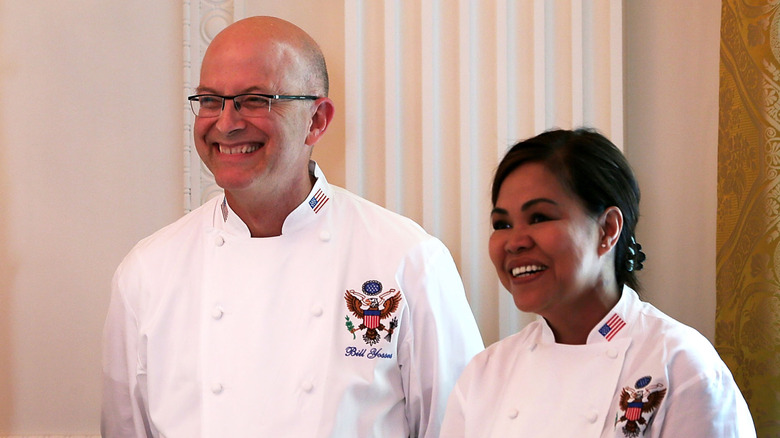White House Chefs Have To Follow Some Very Strange Rules
"Chef" doesn't just refer to someone who can cook well and who heads up a public-facing kitchen, or one special area of the cuisine. Becoming a chef takes an extensive amount of training and certification, and it's a title awarded to only the most creative and hard-working people in the world of food. Once the transition from cook to chef is made, the job opportunities tend to move into the direction of impressive and influential. Among the most important and illustrious kitchen-leading jobs in the world: executive chef at the White House. There are only so many U.S. presidents (one at a time), and only one chef can be counted upon to feed the leader of the free world as well as that official's spouse and children, and to create public and state dinners to remember.
Serving as executive chef in the White House involves a lot of creative chef magic as well as day-to-day regular meal prep. That chef, and their staff, must also abide by a whole series of regulations, and otherwise extraneous tasks they wouldn't find working in a restaurant somewhere. Here then are all of the special and quirky dispensations, steadfast rules, and levels of oversight the White House executive chef has to keep in mind every day.
The White House chef reports to the First Lady
The executive chef runs the kitchens at the White House, and as such, feeds the President and any number of guests, be they visiting dignitaries or heads of state, or members of the staff of the head of the United States government. But the White House isn't just a workplace — it's where the President and their family reside. One of the chief responsibilities of the White House kitchen is to prepare meals for the entire First Family. So while the White House's executive chef is essentially an illustrious position in the government, their work falls under the purview of domestic and household duties. Oversight of the position passes from the President to the First Lady and her staff. The spouse of the sitting president of the United States is charged with the right and responsibility to hire the executive chef.
As the wife or husband of the president can hire the president, they can also fire them, too. The last time it happened was in 2005, when, at the beginning of George W. Bush's second term, First Lady Laura Bush terminated executive chef Walter Scheib. "We've been trying to find a way to satisfy the first lady's stylistic requirements," Scheib told the New York Times (via SFGate), "and it has been difficult. Basically, I was not successful in my attempt."
They must adhere to presidential food decrees
The White House's executive chef, and their main lieutenants, including sous chefs, are employed at the pleasure of the president. This means they don't necessarily work with a contract nor an iron-clad job description. While their boss is the First Lady, they have to do whatever the President tells them to do as far as the task of food procurement and preparation is concerned. In practice, this requires the staff in the White House kitchen to honor presidential requests to not prepare certain foods — ever.
Pierre Chambrin began his tenure as the White House's executive chef in 1989. President George H.W. Bush so loathed broccoli that he briefly caused a minor scandal during his time in office with some public comments about how he loathed the vegetable and didn't have to eat it anymore now that he was an adult. Indeed, he ordered Chambrin and his staff to never stock, cook, or serve broccoli in any shape or form, to anyone — Brussels sprouts, too.
The White House chef and their team is perpetually on call
In addition to their regular duties of planning, cooking, and serving meals both regular and special to the President, their family, and anybody else important who happens to be at the White House on any given day, the executive chef is tacitly always on duty. If the President is on the premises, the entire White House kitchen staff is locked down to the job on a standby basis. "In theory, we're working 24/7," Bill Yosses, a pastry chef serving during the Bush and Obama administrations, told HuffPost.
As it stands, the President has every right to call down to the kitchen and request a midnight snack or a full meal in the middle of the night. Or, if the President convenes their staff at odd hours to address an urgent threat or dire situation, they can request refreshments from the White House kitchen. Somewhat surprisingly, both are rare events. "I was there for eight years and that did not occur," Yosses said of the former. "The crises happened, but they weren't hungry."
A special kitchen staff member has to make elaborate pastries
The crew working with and under the White House's executive chef includes specialists, such as an executive pastry chef. It's certainly a perk of being the President if there's a person in one's employ whose entire job is to make visually impressive and delicious sugary treats. "Most of my day-to-day focus is on desserts for White House events," White House executive pastry chef Susan Morrison told O, The Oprah Magazine in 2016. "I could be creating miniature pastries for a reception on the State Floor or serving sweets for a luncheon in the West Wing. Our top priority, though, is always the First Family."
There's also another important part of the position. The executive pastry chef is charged with constructing an elaborate gingerbread house for each and every winter holiday season. "I spend all year thinking about the White House gingerbread house, but we don't begin baking until November," Morrison said. "Then, for about four days after Thanksgiving, we work tirelessly to build the house before moving it to the State Dining Room, where more than 60,000 guests will cycle through."
The White House kitchen works from the First Family's budget
The White House is objectively a nice place, and they serve a lot of high-end food, prepared by a team headlined by an actual chef, and to very important people in a grand environment. It's like an exclusive restaurant, and as such, it costs a bit of money to keep everything running smoothly. The expenses of the operation are split between taxpayer funds and the President's personal accounts. Official functions, like state dinners attended by hundreds, appetizer sessions, or a meal for the presidential cabinet, are paid for by the government. The daily meals, prepared and served in the White House to the President and his family, are the responsibility of the First Family.
It's part of the job of the executive chef of the White House to keep track of everything that the President, their spouse, and immediate family consumes. All the personal meals are logged and then assigned a price value, and they all appear on a monthly bill sent to the President. It's up to them to pay it in a timely fashion, out of the presidential salary.
White House chefs will make whatever weird thing the president wants
The executive chef, as well as other members of the White House kitchen staff, work on an on-call basis in addition to their regularly scheduled and planned duties. They're also required to fulfill the whims of the president on the level of food specificity, too. The executive chef will honor whatever requests may come in from the President of the United States, no matter how seemingly outlandish or how little they want to add it to the menu.
For example, President Dwight D. Eisenhower, who loved his steaks cooked in a bizarre way, declared as one of his favorites a now obscure dessert pudding called prune whip. President Richard Nixon favored cottage cheese slathered with ketchup, inspired by his grandmother who often ate the dish and lived into her nineties.
Less strange but equally singular is the small-batch beer, which has now since disappeared, made by the White House kitchen at the suggestion of President Barack Obama. "Brewing beer is becoming a thing that Americans are doing in their homes and garages across the country. And the President certainly thought it would be a good idea to see if we could join the American people in that time-honored tradition and brew some of our own beer," assistant chef Sam Kass said in a White House video.
The White House kitchen screens the food for safety
It was dangerous and nerve-wracking to be a unilaterally powerful leader in antiquity and the medieval era. Constantly and rightfully worried that an enemy or supposed ally would murder them in a power grab, nobles and antiquity employed food tasters. Their position: Take a bite of the ruler's food and drink to ensure that it hadn't been laced with deadly poison. In the contemporary United States, a rumor turned legend persisted that the president also kept on their staff an employee to check for adulteration; in 2020, the White House was reportedly in search of an official food taster.
The real answer: It's complicated. "There is no presidential food taster," former White House chef Walter Scheib told the Washingtonian. However, the President must be kept safe, and so more sophisticated measures are used to ensure that the President's food isn't injurious or deadly. All food that a president may touch or eat has been cleared by the staff beforehand. "Nothing gets to the President that hasn't fallen under somebody's jurisdiction," Scheib promised. "If the President is just grabbing a pretzel randomly at the table, it's been screened."
White House chefs receive high security clearance
It's hard to even sneak some foods past airport security, let alone onto the Commander and Chief's plate. In addition to clearing all dishes and ingredients for safety before it reaches the President of the United States, the executive chef of the White House who oversees all the food must themselves also be certified as a non-threat to the nation's most elevated elected official. As such, the White House's executive chef, as well as everyone else who works in the kitchen near and for the President, must be granted security clearance.
The government needs to be able to rest easy that the people making food for the president aren't going to try to hurt the U.S. President. After passing scrutiny, kitchen workers are bestowed with a rare and high-end level of clearance called Top Secret Presidential Proximity. "If you think about it, we're not just around outside and next to the President; we're physically inside of him," former White House executive chef Walter Scheib told Vice. "You really couldn't get any more close to that."
The White House kitchen will adhere to kosher rules
Kosher is a system of Jewish dietary laws laid out in the Torah. Adherents pursue a physically and spiritually clean way of eating with those rules in mind, which involve general and specific guidelines like avoiding pork and not mixing meat and milk at the same meal. There are a lot of reasons for an institution to go kosher, and the White House kitchen will adopt those rules when necessary.
In 2011, the administration of President Barack Obama held the first ever full White House event to observe and celebrate Hanukkah. An important holiday in the Jewish religion, the food for the night— set to be attended by more than 500 people, including politicians and members of the Supreme Court — was intricately prepared days ahead of time in accordance with kosher law. To ensure that the White House executive chef and their staff, who were not necessarily well-versed in kosher cooking, followed proper procedure, three rabbis oversaw the food preparation.
State dinners come with their own set of rules and regulations
Preceded by a legendary reputation, a state dinner at the White House is a classy, fancy, and very special engagement. They are presented occasionally by the White House, when the President of the United States welcomes a sitting monarch or the elected head of a government who has arrived in the country on official government business. Hundreds may attend the formal banquet, and the volume of guests that expect the highest quality of food and service may only add to the stress and pressure placed on the White House executive chef to pull off a memorable and pleasant multi-course meal.
The dinner follows a particular series of customs and an order of operations, traditional in the sense that it's how state dinners have always been conducted. Because The White House dinner is reminiscent of courtly dinners of the heyday of European royalty, the procedure of preperation is strictly adhered to, and the executive chef leads the charge. As a matter of course, second helpings are not offered to diners, but if a guest specifically asks for more, their request is quickly granted. Also, the state dinner works on a time-frame of 55 minutes — that's how much time is allowed to elapse from the placement of the first course to the serving of the final course.
White House chefs are in charge of special events
The White House kitchen, under the purview of its executive chef, is pretty much responsible for any food or food-related items that are a part of any official event that's staged on the grounds of the historical presidential mansion and workspace. Probably the most famous annual occurrence would be the White House Egg Roll. Held around Easter most every year since the 1870s, it's just for the kids, who each push an egg across the White House's South Lawn with a long-handled spoon. Other games and activities, like an Easter egg hunt, are generally included, but the Egg Roll is the main attraction, and one that's conducted with real hard-boiled and brightly dyed eggs.
Who has to cook and color the enormous amount of required eggs each spring? That would be The White House kitchen. In 1998 alone, the team that usually prepares the First Family's meals and state dinners took on the less complicated but substantially more time-consuming task of getting 7,200 eggs ready for the Roll. And while those eggs are boiled to perfection by a team of expertly trained chefs and cooks (not that boiling an egg takes an expert), they aren't meant for eating — their only purpose is to be rolled around on the ground.
White House chefs are subject to a meager pay scale
While it's an accomplishment to be the executive chef at the White House, the pay doesn't match the prestige. It's an incredible amount of work, cooking everyday for a powerful person and their families, not to mention getting state dinners and other formal functions off the ground, and for all that, the White House executive chef earns less working for the President of the United States than they would in the private sector.
As of 2025, an executive chef leading a kitchen in a major restaurant in Washington, D.C., not far from the White House, earns an average of about $111,000 a year, or as much as $142,000 annually. That's more than the executive chef position at the White House pays — as of 2017, they might take home as much as $100,000 a year. This salary is probably hard to negotiate — running the White House kitchen is technically a government job, and those are subject to very tight and planned out budgets. Another unattractive and unbreakable rule about the White House chef job is that it doesn't pay overtime or account for on-call hours. It's a purely salaried job.
Even though they're public employees, a certain amount of discretion is required of executive chef candidates. Those chefs under consideration cannot comment on the hiring process. "You know the rules of the house," Cristeta Comerford told the New York Times in 2005, just before she was appointed executive chef.
